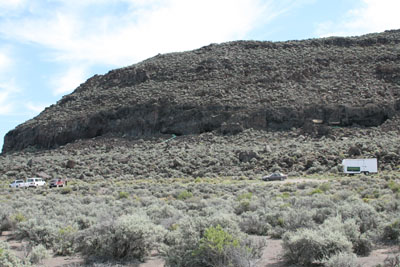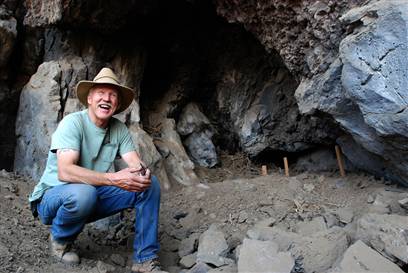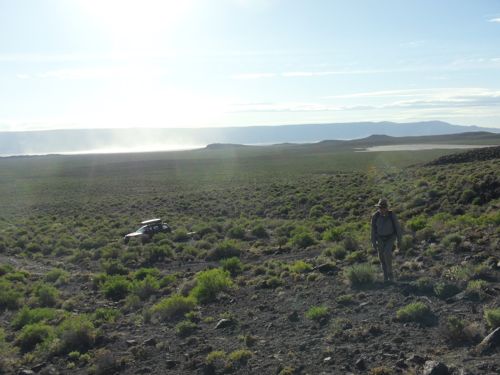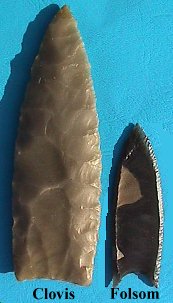
Another place we wanted to stop on our road trip was Paisley Caves. Both my mother in law in Oklahoma, Kathy Cupp, and my parents, Marty and Sarah in Oregon, had saved an article about the archaeology going on there. Apparently Dr. Dennis Jenkins has recently found what appears to be the oldest human DNA ever found in the Americas. They have found tools, basket pieces, string, bones and what they call coprolites (ancient poop). Apparently these have been dated at between 12,750 and 14,290 years ago! Wow! We HAD to go check it out. I tried to contact Dr. Jenkins via email and phone before going but had no luck, so in the end we just drove out to Paisley. After two days in the desert we were low on food and fuel so we stopped in town. In the grocery checkout line the clerk asked the guy in front of us, "So, did you find anything interesting out there today?"
"Yeah, actually we found a big piece of obsidian," he answered.
It was one of the archaeologists! Turns out they were staying in school dorms across the street!
After a long day digging through dry pack-rat urine and desert dust, they like to sit in their lawn chairs in the cool Chewaucan River.

Dr. Jenkins and his team from the University of Oregon Field School were really friendly. We met with them at the caves the next day to watch them work the "units" where they were digging. Dr. Jenkins - who grins really big under his dusty wide-brimmed hat - casually explained the history of the last 20,000 years from our viewpoint by the cave entrance. It was neat to think that ancient people all those years ago had a similar view - except the valley below used to be filled with a vast lake and that has dried up quite bit. He showed us where the former water line had been 20,000 years ago and then again 14,000 years ago as the lake dropped. Its waves had washed into distant hillsides and even eroded the very caves he was exploring.
"They are bathtub rings basically," he said.
People moved into the caves about 14,500 years ago when the lake was about a mile or so away from the cave, he said.
"You'd be able to see a herd of large mammals literally for miles from up here," he said. "This would have been an excellent environment at that time."

As we talked a student in jeans and a ball cap came up.
"Sorry to interrupt, sir, but we found something." he said.
He held out a small, black, obsidian piece which had been shaped on both sides to make an edge.
"Bifacial scraper?" called out a girl in a mask shoveling nearby.
Dr. Jenkins turned it over in his hand.
"Yeah, and somebody used this as a core, too. See right here? But it didn't work too well, did it?"
Unfortunately my camera battery had died by this time so I didn't get any pictures from the caves, but I found some on the web.
Jenkins said the tools and other artifacts are important, but he's getting more and more excited about DNA evidence. He talked about something called a quid which is a chewed fiber wad people used for various things.
"It's just saturated with human DNA," he said. "I'm just a dirt archaeologist but I'm convinced DNA evidence is going to become a new way of looking at things that we're going to have to pay attention to."
I mentioned that Dr. Jeff Rasic on our expedition to Alaska this sumer is working with a specialist in ancient DNA. It's so strange to think the people who left the points way up there might be related to the people who left these in Oregon. Would their language have sounded anything alike?

One of the things archaeologists get really excited about is Clovis. This is a certain type of arrow or spear point with flutes or grooves running lengthwise along the point. I have a lot to learn about this, but apparently Clovis and Folsom points are really important because they are the only type of points which have been found with extinct animals - proving they were used a long time ago. Jenkins has found the remains of extinct horses, bison and camels at Paisley Caves, but has found no Clovis points. In contrast, points showing fluting grooves have been found up in Alaska where we will dig in two weeks. Why is there fluting way up in Alaska if it wasn't invented until later by people down south? Was it invented up along the Bering Land Bridge and brought down south? Or was it invented down south and brought back north by people hunting game?
"So, this is what science is all about," said Jenkins with a laugh. "We're hashing it out."


Comments